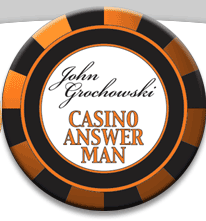If you've been my casinos columns for very long, you've seen the
numbers a hundred times: The house has a 5.26 percent edge on American
double-zero roulette, a 1.41 percent edge on the pass line at craps, a 2
to 2.5 percent edge against the average blackjack player, but only a
half-percent or so edge against a basic strategy player.
Chances are you use those numbers as a rough comparison of games.
Which give you the better shot to win? Which are nothing more than
"house" games? And that's fine. You do have a much better shot to win if
you're betting the pass line at craps than if you're playing roulette.
But those numbers are also statistical averages. They don't mean that
every time you bet $100 on the pass line, you're going to lose $1.41,
or even that every 100 times you bet $100 on pass, you'll lose $141.
If the losses were that regular, and that certain in the short term,
no one would play. Even on the casino games with the highest house
edges, results are volatile enough that players will win sometimes.
Given enough trials, though, the house edge will hold up, and the
more trials there are, the closer the results will be to giving the
casino its expected profit.
One of the more colorful descriptions of how this all works came from the late Peter Griffin, author of the classic The Theory of Blackjack.
I'd been invited to spend a week as a student at the Harrah's Institute
for Casino Entertainment in Las Vegas, a crash course in casino
operations designed to give gaming basics to non-gaming employees
Harrah's had marked as up-and-comers. Griffin was a guest instructor.
Imagine a situation, he told us, in which a busload of roulette
players have finished for the day and are in the waiting room, waiting
to board for the trip home. They decide they have time for one last spin
of the wheel if each of the 100 players gives $100 to a casino manager
with instructions to place the bets. (This takes place in a jurisdiction
with a particularly lenient gaming board, I might add.)
The manager puts all the money --- $10,000 worth --- in a big box,
and climbs a staircase to a balcony overlooking the waiting room. He
then takes out $526 --- more or less --- and dumps the rest of the money
back over the railing to the waiting bus group.
Players scramble for the money. Some get back their $100. Most get back less. Some get more --- a few get considerably more.
There are winners. There are losers. And the house has its 5.26 percent.
Slot machines work the same way. When we say quarter slots at a given
casino return an average of 93 percent to players, that's just another
way of saying the house edge on those machines is 7 percent. If you play
$100 through a quarter slot at that casino, are you likely to wind up
with precisely $93? No, most of the time you'll wind up with less. Much
of a slot machine's long-term return is tied up in larger jackpots, so
sometimes you'll win hundreds, or even thousands of dollars for that
$100 in play. You may win big, or more often lose fast, but on balance
over hundreds of thousands of plays, the house will get its 7 percent.
If you go to the casino and play a couple of hours on a three-reel
quarter slot, you might spin the reels 1,000 times --- 500 plays per
hour is a busy, but not hectic, pace. With a three-coin maximum bet,
you're risking $750. If the machines in that casino return 93 percent,
your expected average loss is $52.50, but you won't land precisely on
that figure very often. Most of the time, you'll lose somewhat more than
that. Less often, you'll get a big hit or a few medium-sized wins and
walk away a winner. In one short trip to the casino, there's no telling
what your results will be.
But let's take a page out of Griffin's book and say you're on a bus
trip with 100 players all spending a couple of hours on those 93-percent, quarter slots, all
betting 75 cents a spin for a total of 1,000 spins each. Now your group
is setting the reels spinning a total of 100,000 times, and the casino can
almost count on getting something close to its 7 percent take.
There almost certainly will be a winner, or several winners, in your
group. There also almost certainly will be those who lose fast and wind
up dropping a couple of hundred dollars. The majority will lose some of
their money. All told, your group is likely to leave behind a total very
close to $5,250 on its $75,000 worth of wagers.
There are winners. There are losers. And the house has its 7 percent.
That's the way it is when you look around any busy casino. A few are
winning. Most are paying for their day's entertainment. It's the hope
that this time we'll be one of the winners that keeps us going.

Please keep posting these
ReplyDeleteglamour me studio
Thank you. Please spread the word. As long as people are reading, I'll keep posting.
ReplyDelete